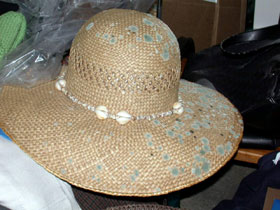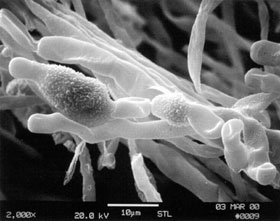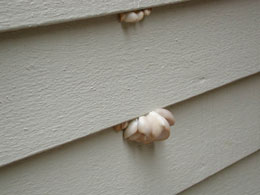Fungal Facts
Air Date: Week of June 18, 2004
The problems of mold range from nuisance to nightmare, and seemingly harmless fuzz can ripen to full-blown infestation in the wrong conditions. Husband and wife Jeffrey and Connie May know mold intimately. They run a mold investigating business in Cambridge, Massachusetts. The Mays tell Living on Earth host Steve Curwood about some of the challenging and, sometimes, heartbreaking cases they’ve been called in to clean up, and how the average homeowner can guard against even the most persistent spores.
Transcript
CURWOOD: From the Jennifer and Ted Stanley Studios in Somerville, Massachusetts, this is Living on Earth. I’m Steve Curwood.
We begin our program this week with an examination of … mold. Okay, granted, not the world’s most pressing problem these days, but if mold gets trapped in your carpets, or festers between walls, it can make you sick to the point you may have to evacuate your home. Chronic problems with mold spores have spurred an industry of cleanup crews and special investigators who sniff out the source of stubborn mold growth and get rid of it.
Joining me now are husband and wife Jeffrey and Connie May. They run a mold detective agency in Cambridge, Massachusetts, and field all sorts of calls for fungal emergencies. They’ve written a book on the science and sources of mold, and how you can rid your home of even the most persistent spores. It’s called “The Mold Survival Guide: For your Home and for your Health.”
Jeffrey and Connie May, welcome to Living on Earth.
C. MAY: Thank you. Thank you for having us, Steve.
J. MAY: Thank you, Steve.
CURWOOD: So, what exactly is mold? I understand that there are a lot of varieties but, principally, what do we come in contact with in our homes?
J. MAY: Well, mostly we come in contact with the spores, which are sort of the reproductive seeds of mold. But mold is a plant-like growth, and wherever it’s warm and damp the spores will germinate and start to grow. Most people are familiar with the colonies – they see little round dots, maybe it’ll be on the bathroom ceiling, or it’ll be on the outside of the house.
Most of the molds are either black or brown or sort of greenish or bluish colored. But some are white. And, you know, a lot of people say mold is everywhere. And I think that’s a shame, it’s a real misconception, because although spores are everywhere in the air – because they’re dispersed by the wind – mold is not everywhere. And it’s very unhealthy to live in a house where there’s mold anywhere, or to be in a building. You should not have mold -- visible mold -- on the ceiling tiles, you shouldn’t have visible mold on walls, because the mold produces billions – one colony like that, that you can see, produces millions to billions of spores.
CURWOOD: So, what happens to somebody if, in fact, the mold is in their house?
J. MAY: Well it really depends. Some people get asthma, some people develop chronic coughs, other people have asthma symptoms. But just the fact that you see mold on a surface doesn’t necessarily mean that you’re breathing it. And, in some situations, I’ve actually test-sampled the air where there was a lot of mold – say on a wall or a ceiling – and not found any mold spores at all.
 This straw hat was in a home where the furnace humidifier malfunctioned while the family was away on a winter vacation. (Photo: Jeffrey May)
This straw hat was in a home where the furnace humidifier malfunctioned while the family was away on a winter vacation. (Photo: Jeffrey May)
C. MAY: Yeah, people call us up and they’re worried about the mold they see in their attic, or they’re worried about the mold they see on their bathroom ceiling. But it’s really the mold that they don’t see in their basement carpets, or in the fiberglass insulation, that’s going to be contaminating the air they breathe.
CURWOOD: Connie, in your work in helping people figure out how to straighten their homes out from mold, what are they key things that you look for? Where do people typically get into trouble with mold at home?
C. MAY: Well, moisture control is, I think, of paramount importance. And when people think about moisture control they think about leaks and visible water that intrudes into their home one way or another. And really, it’s relative humidity that’s the biggest problem in homes.
CURWOOD: Relative humidity? This is uncle, or your aunt?
C. MAY: (LAUGHS) No, relative humidity is a measure of how much moisture the air holds in relationship to how much it can hold at any given temperature. So, if air at a certain temperature is 70 percent relative humidity, it means it can hold 30 percent more before it’s saturated. And many kinds of molds can flourish in 70 percent relative humidity, in the absence of liquid water. And people don’t understand this so they allow conditions to arise in their homes that are conducive to mold growth. And then they worry about the leak behind the bathroom wall whereas, really, it’s the basement carpet that’s the problem.
J. MAY: The reason why we’re not all having mildew everywhere is because you need consistent periods of relative humidity in order for the growth. So, if the relative humidity, let’s say in the bathroom, goes up to 85 or 90 percent for 15 or 20 minutes, you open the door and then it drops down again. So, time is really important as well as the, you know, the relative humidity.
CURWOOD: Okay, somebody’s got a mold problem. What’s the sure-fire way to get rid of it? In your book you say that bleaching isn’t enough.
J. MAY: It’s pretty complicated so it’s not something you could really just, you know, give somebody advice. I made that mistake once. I was talking about maybe using a little bleach on an air conditioner. And then I suddenly realized, you know, if you’re on the fourth floor of an apartment house and you pour a quart of bleach into your air conditioner, somebody down on the street is going to be walking along. They’ll probably end up blind or you’ll bleach their red shirt or something.
So I think cleaning advice – it’s complicated. But a good example, I’d say, would be in a bathroom. People have been cleaning mildew out of their bathrooms for years and that’s certainly a perfectly doable task. On the other hand, if you got a basement full of mold then you may have to get some professionals to do that, and you have to be very careful, particularly if people who are sensitized or involved in the cleanup.
But the big mistake that anybody can make is to clean up a big mold problem and then not really change the conditions that led to the growth. You can clean things up – and we get calls like this all the time from people, you know: “We bleached the bathroom again and there’s mildew everywhere, and what’s wrong? Why do we have to keep doing this?”
C. MAY: Or, “we spent $5,000 and had professionals clean our basement and now there’s mold again.” And meanwhile, they’ve got cardboard boxes directly on the concrete slab and they’re not dehumidifying the basement so mold comes back. It’s not like lead paint – it’s not either there or not there. It’s a living thing so it will re-occur.
CURWOOD: You write in your book that “mold is gold.” That, well, the business of mold removal, dare I say, has mushroomed along with the awareness? [LAUGHTER] Can you talk about this, and tell me what you’ve come across along these lines personally?
C. MAY: Well, I think that mold is certainly a concern and something to take very seriously but I also think that because they’re so worried about it, people have been sort of duped. And we’ve had people who’ve called up with a soot problem in their home and they think it’s mold or they have efflorescence in their basement and they’ve been told they need a $10,000 cleanup job and they move into a hotel. And it’s not mold. So, I think understanding it will help people reach clarity about when to worry, when not, what is and what isn’t mold.
J. MAY: You know, the mold is gold…they have special courses for attorneys on how to litigate mold problems, they’re traveling around the country. There’s courses for mold inspectors on how to sample for mold and there are labs that are sprouting up everywhere and a lot of them really aren’t all that competent. So it’s a wild west sort of frontier out there.
CURWOOD: Jeff, you say in your book up front that you have mold allergies and yet you work with it everyday. Why do you do this to yourself?
J. MAY: Well, it’s a little crazy but, actually, we try and help people and I use my own sensitivity really to help find problems. But I do also have some pretty sophisticated instrumentation that I use. So, what it does, the way it helps me is that it directs me to the place where there are problems. If people who are not sensitized go into a space, they don’t know where to start but I know where to start.
CURWOOD: So, what’s it like to live with somebody who is highly allergic to mold and yet dives into it everyday?
 Cladosporium spores are often the most abundant type of spores, found in air both indoors and outdoors. (Photo: Jeffrey May)
Cladosporium spores are often the most abundant type of spores, found in air both indoors and outdoors. (Photo: Jeffrey May)
J. MAY: 16,000 samples.
C. MAY: Sixteen thousand samples that he’s taken. So, what’s it like? I’ve gotten used to being married to someone who’s brilliantly obsessive
CURWOOD: What if some of this mold escapes into your house?
C. MAY: You’ve been doing it for fourteen years and nothing’s ever escaped.
J. MAY: Actually once I did. I dropped one Petri dish that was full of mold and I was so fearful but the first thing that I did was I slammed the door shut and then I got an air sampler out because I wanted to see how bad it really was. And it was this penicillium mold and the entire room was full of spores. And then I put an exhaust fan in the window for five minutes and I took a sample again and it was all gone. So it was important to me to know that in minutes you could get rid of a problem like that.
CURWOOD: Connie, how do you see mold and fungi?
C. MAY: Well I used to think it was disgusting [LAUGHS]. But now that I’ve watched Jeff become so interested and I’ve learned so much about it I think it’s very interesting but for me, also, it’s a human story because I’m the person whose on the frontlines in terms of talking with people when they first contact the business. And so, I’m the first person who hears these terrible stories and speaks with usually women, often women, and usually when there’s another woman on the phone when they call they often are crying, they’re often dealing with children who are very, very sick. And so, for me, mold is, of course, part of science and nature but it’s also a human drama and that to me is both interesting and kind of tragic.
CURWOOD: Tell me one of the most compelling stories you’ve heard.
C. MAY: Well, I think one of the most compelling stories I heard was the family with the little girl, she was four, was she, Jeff? On the couch, remember she was?
J. MAY: Oh, right. Younger even.
C. MAY: She was three, she was taller. And her asthma was so bad that her parents took turns sleeping in her room every night on a mattress on the floor so that they could give her her medication with a nebulizer. And they’d done everything they could possibly think of to clear the house of allergens: they’d removed all the wall to wall carpeting, they’d gotten rid of all the curtains, they put extra filtration in the system, they’d gotten a vacuum. A whole long list of things that they’d done and still she was getting very, very sick. And Jeff went over to the house to do testing and found that the furniture was contaminated and the parents had said “well she doesn’t go into that room,” but they didn’t realize that every time someone sat on the furniture allergens became airborne and went with airflows to where she was. So within two weeks, she was off her nebulizer and they had a normal life with her. So I found that very moving.
CURWOOD: Now, I’m looking at your book here, Jeff, and along with your experiences and instructions you have some pretty vivid pictures of mold. Here is, looks like a fungus growing out the side of a house?
|
|
CURWOOD: I have to ask you…these are pretty vivid pictures and I can’t help but think that you find these pictures kind of fascinating. J. MAY: Absolutely. It’s part of nature; it’s an extraordinary beautiful thing when you look at these things under a microscope, it’s incredible. And you see how all the different living things interact with each other, you know, the mold, the bacteria, the insects that eat them. I can’t take my eyes off them. I guess it’s just another world. C. MAY: It’s nature’s recycling. J. MAY: Yep. CURWOOD: Jeffrey and Connie May are authors of called “The Mold Survival Guide: For your Home and for your Health.” Thanks so much for taking this time with me today. J. MAY: Thank you, Steve. C. MAY: Thank you. CURWOOD: Coming up -- the growing trend to help people find out just how many toxic chemicals have built up in their bodies over the years. Biomonitoring is next. Stay tuned to NPR’s Living on Earth. [MUSIC: “City of Pleasures” GOVINDA (Earthtone) 2002] Links
|

 These mushrooms appeared at the side of a house between the time a buyer’s offer was accepted and the day the home inspection occurred. (Photo: Jeffrey May)
These mushrooms appeared at the side of a house between the time a buyer’s offer was accepted and the day the home inspection occurred. (Photo: Jeffrey May) 



